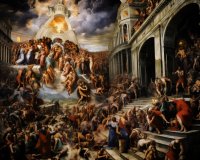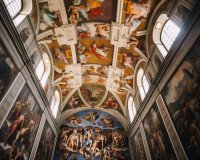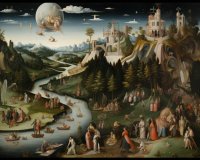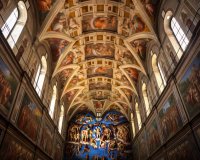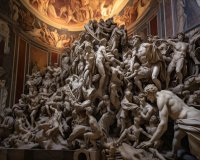The Story Behind the Creation of Sistine Chapel’s Ceiling
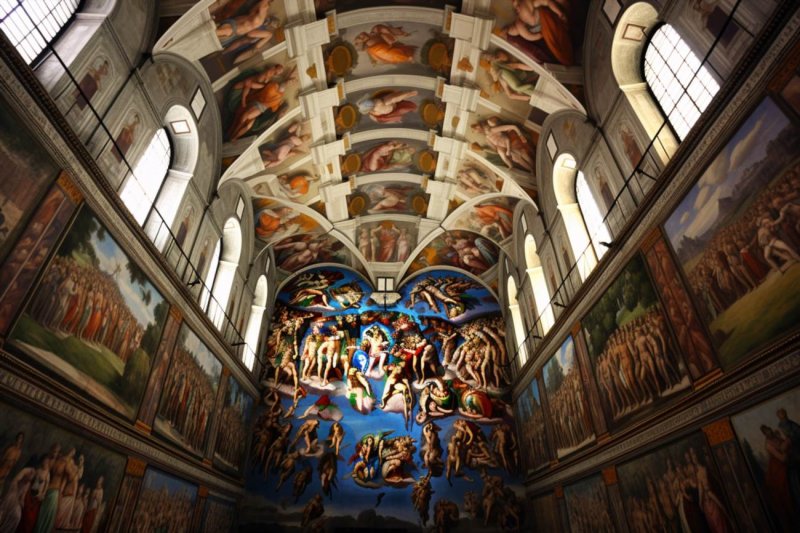
The Story Behind the Creation of Sistine Chapel's Ceiling
The Sistine Chapel, located in the heart of Rome, is one of the most iconic and revered works of art in the world. While the entire chapel is a masterpiece in itself, it's the ceiling that has captured the imagination of art lovers and historians for centuries. The story behind the creation of the Sistine Chapel's ceiling is a tale of talent, dedication, and innovation that continues to inspire people to this day.
Michelangelo Buonarroti, the renowned Italian Renaissance artist, is the genius behind the Sistine Chapel's magnificent ceiling. In 1508, Pope Julius II commissioned Michelangelo to paint the ceiling of the chapel, a project that would become one of the greatest artistic achievements in history.
The Genesis of a Masterpiece
Michelangelo was initially reluctant to take on the project. He considered himself primarily a sculptor, not a painter, and he believed the task was beyond his expertise. However, Pope Julius II was insistent, and Michelangelo eventually agreed to the monumental task.
What followed was a laborious and challenging creative process that spanned four years, from 1508 to 1512. Michelangelo's technique was fresco, a method of painting on wet plaster that required meticulous precision and speed. He worked lying on scaffolding for hours on end, with paint dripping down onto his face as he brought the stories of the Bible to life.
The Iconic Scenes
The Sistine Chapel's ceiling is adorned with nine central panels depicting stories from the Book of Genesis. The most famous of these panels is undoubtedly "The Creation of Adam," which portrays God reaching out to touch Adam's finger, giving life to humanity. This image has become a symbol of human potential and divine inspiration.
Other panels on the ceiling include "The Creation of Eve," "The Deluge," "The Sacrifice of Noah," and "The Drunkenness of Noah." Each of these scenes is rendered with an incredible attention to detail and a profound understanding of human anatomy and emotion.
The Last Judgment
After completing the ceiling, Michelangelo took a break from the Sistine Chapel project. However, he was summoned back years later to paint the chapel's altar wall. The result was "The Last Judgment," a depiction of the second coming of Christ and the final judgment of souls. This massive work was completed between 1536 and 1541 and replaced an earlier fresco.
The Last Judgment is an awe-inspiring portrayal of heaven, hell, and purgatory. It's a testament to Michelangelo's evolving artistic style, moving towards a more dynamic and emotional approach. The fresco is filled with over 300 figures, each displaying intense expressions and conveying the complexity of the human condition.
The Legacy
The Sistine Chapel's ceiling and "The Last Judgment" remain some of the most celebrated works of art in human history. They have inspired countless artists and continue to draw millions of visitors to the Vatican every year. Michelangelo's ability to capture the essence of the divine, the human spirit, and the human body in his artwork is a testament to his extraordinary talent.
Today, the Sistine Chapel is not just a place of worship but also a symbol of the artistic and cultural achievements of the Renaissance. It serves as a reminder of the power of creativity and the enduring legacy of those who dare to dream and bring their visions to life.
In conclusion, the story behind the creation of the Sistine Chapel's ceiling is a tale of artistic genius, determination, and the unrelenting pursuit of perfection. Michelangelo's masterpiece continues to inspire awe and admiration, reminding us of the boundless potential of human creativity.
Rome: Vatican Museum and Sistine Chapel Official Guided Tour
Discover the awe-inspiring art and design of the Vatican Museums and Sistine Chapel with a skip-the-ticket-line entry. Uncover the rich religious history within these iconic buildings accompanied by an enthusiastic guide.
Experience Highlights
- Explore the Vatican Museums and the Sistine Chapel with the guidance of an enthusiastic tour guide.
- Fast-track access inside the museums with a skip-the-ticket-line privilege.
- Marvel at the astonishing interiors and artworks housed in Rome's most iconic buildings.
- Witness Michelangelo’s masterpiece, "The Creation of Adam".
- Embark on the official guided tour of the Vatican Museums and Sistine Chapel.
Full Description
Skip the ticket line and enjoy swift access to both the Vatican Museums and Sistine Chapel. Meet your guide inside and delve into the intriguing story behind the seminal design of these monumental structures. Begin your journey in the Pio Clementino Museum, where you'll witness classical Roman and Greek sculptures up close. Continue through the galleries adorned with marble structures and renaissance artworks. Marvel at the 40 maps frescoed on the walls of the Gallery of the Geographical Maps and the hanging tapestries in the Gallery of the Tapestries. Explore the exquisite Raphael Rooms and culminate your experience by immersing yourself in Michelangelo's breathtaking fresco, "The Creation of Adam," within the Sistine Chapel.
Includes
- Skip-the-ticket-line entrance.
- Official guided tour.
- Ticket to St.Peter's Basilica (entry is free however not guaranteed due to crowd control).
- Access and guided tour of St. Peter's Basilica's dome.
Meeting Point
Enter the Vatican Museums by presenting your voucher at the outside entrance. Follow the signs to the "GUIDED TOUR DESK" where your guide will be waiting for you.
Important Information
Remember to bring your passport or ID card. Dress appropriately, covering shoulders and knees, to adhere to the Vatican's dress code. St. Peter's Basilica and the Square may have limited access on Wednesday mornings due to the Papal Audience. Children under 6 years old enter for free. Be punctual, as late arrivals will not be accommodated. All visitors must pass through airport-style security, and during peak seasons, the security wait time may be up to 30 minutes.
The Artistic Marvel: Michelangelo and the Sistine Chapel in Rome
When we think of the Italian Renaissance, the name Michelangelo immediately comes to mind. His extraordinary talents as a sculptor, painter, and architect left an indelible mark on the world of art and culture. One of his most renowned masterpieces is the awe-inspiring Sistine Chapel in Rome.
The Sistine Chapel, officially known as the Cappella Sistina, is located within the Vatican Museums in Vatican City. It is not only a place of worship but also a testament to human creativity and devotion. Michelangelo's involvement in the Sistine Chapel's decoration is a story of passion, dedication, and artistic genius.
Michelangelo's Commission
The Sistine Chapel's history as an artistic and religious icon began in the late 15th century when Pope Sixtus IV commissioned a restoration and enhancement of the chapel. It was Pope Julius II, however, who would play a pivotal role in the chapel's transformation. He summoned Michelangelo to the Vatican in 1508 with an ambitious project in mind: to paint the chapel's ceiling.
At first, Michelangelo was primarily a sculptor, having already carved masterpieces like the 'David' and 'Pieta.' He was initially reluctant to take on the task of painting the chapel's vast ceiling. Still, Pope Julius II's insistence and his own desire to prove his artistic versatility led him to accept the challenge.
The Creation of the Ceiling
Over the course of four grueling years, from 1508 to 1512, Michelangelo toiled atop scaffolding, covering the 12,000 square feet of the chapel's ceiling with a breathtaking fresco. The masterpiece featured a series of biblical scenes, from the creation of Adam to the Last Judgment, and is celebrated for its anatomical precision and emotional depth.
One of the most iconic images from the ceiling is the 'Creation of Adam,' depicting the moment when God reaches out to touch Adam's finger. This image has become an enduring symbol of divine inspiration and the potential of humanity.
The Last Judgment
After completing the ceiling, Michelangelo was once again called to the Sistine Chapel in the 1530s, this time to paint 'The Last Judgment' on the altar wall. This monumental fresco portrays the second coming of Christ and the final judgment of souls. It is a powerful and dramatic work of art, filled with intricate details and complex symbolism.
Michelangelo's depiction of heaven, hell, and the souls in between is a testament to his unparalleled skill as an artist. 'The Last Judgment' remains a subject of fascination and contemplation for art lovers and scholars worldwide.
Legacy and Impact
The Sistine Chapel's ceiling and 'The Last Judgment' are not only testaments to Michelangelo's artistic genius but also to the enduring power of art to inspire, provoke thought, and communicate complex ideas. These works continue to draw millions of visitors to the Vatican each year, and their influence can be seen in countless art forms, from painting to literature to film.
Michelangelo's contributions to the Sistine Chapel have left an indelible mark on the world of art and culture, and they serve as a reminder of the heights that human creativity and dedication can achieve. The Sistine Chapel remains a place of pilgrimage for art enthusiasts and a symbol of the enduring legacy of the Italian Renaissance.
In conclusion, Michelangelo's involvement with the Sistine Chapel in Rome is a remarkable chapter in the history of art. His ability to transform a sacred space into a masterpiece of creativity and spirituality is a testament to the power of artistic vision and dedication. The Sistine Chapel, with its iconic frescoes, continues to inspire and captivate people from all corners of the globe.
Rome: Vatican Museums & Sistine Chapel Skip-the-Line Ticket
Explore the Vatican Museums and Sistine Chapel with this skip-the-line entrance ticket provided by Eternal Rome Tours. Delve into the Renaissance period as you bypass the waiting lines and step into the world of art and historical artifacts.
With your skip-the-line ticket, enter the Vatican Museum and Sistine Chapel without any delays. Marvel at over 20,000 artworks created by renowned painters such as Michelangelo, Raphael, and more. Witness the brilliance of Michelangelo's masterpieces, including 'The Creation of Adam' in the Sistine Chapel.
Your journey begins in the main hall where you will receive your tickets, skipping the long entry lines. Admire significant sculptures like Laocoön and His Sons at the Museum Pio-Clementino. Explore the Belvedere Torso, Round Hall, and the Raphael Rooms, each adorned with unique frescoes depicting various scenes and subjects.
Continue your exploration to the famous Room of Constantine and Room of Heliodorus. Be captivated by the remarkable frescoes created by Michelangelo, Botticelli, and Ghirlandaio in the Sistine Chapel.
Throughout your visit, immerse yourself in the rich collection of ancient sculptures, Renaissance paintings, tapestries, manuscripts, and archaeological findings. Experience the Renaissance era at your own pace, appreciating the artistry and historical significance of each exhibit.
Highlights:
- Enter the Vatican Museums and Sistine Chapel with a skip-the-line ticket.
- Explore over 20,000 artworks by renowned artists like Michelangelo and Raphael.
- Admire Michelangelo's masterpieces, including 'The Creation of Adam' in the Sistine Chapel.
- Visit significant museum spaces like the Raphael Rooms, Gallery of Maps, and more.
- Marvel at ancient sculptures, Renaissance paintings, tapestries, manuscripts, and archaeological findings.
Important Information:
Please wear comfortable clothes for your visit. Shorts and sleeveless shirts are not allowed. You will need to pass through airport-style security, so plan accordingly.
Meeting Point:
Please look for your host holding a sign with the activity provider’s logo at the meeting point.
Customer Reviews:
Overall Rating: 4.3/5 based on 354 reviews.
Travelers have praised the straightforward and easy process of entering the Vatican without waiting in a queue. This experience is perfect for independent exploration, allowing visitors to enjoy the museums and chapel at their own pace.
The Initial Reactions to the Frescoes in Rome
When it comes to the artistic and historical treasures of Rome, the frescoes that adorn the city's many churches, palaces, and archaeological sites are among the most captivating and enigmatic. These magnificent artworks, which have been preserved over centuries, continue to elicit awe and admiration from both art connoisseurs and casual tourists. In this article, we will delve into the initial reactions to the frescoes in Rome and explore the profound impact they have had on the world of art and culture.
The term "fresco" itself originates from the Italian word "affresco," which means "fresh." This technique involves painting on freshly laid wet plaster, allowing the pigments to become a part of the wall or ceiling as they dry. This method of painting has been practiced for centuries and was prominently used during the Renaissance in Italy, where it reached its zenith in terms of artistic expression.
One of the most famous frescoes in Rome is found within the Sistine Chapel, painted by the legendary Michelangelo. Upon its completion, it caused an immediate sensation and drew admiration from all corners of the art world. The frescoes in the Sistine Chapel, particularly the ceiling with its iconic "Creation of Adam," remain a symbol of human artistic achievement and the power of religious storytelling.
Another set of remarkable frescoes can be found in the Basilica of San Clemente, a church that is itself a historical marvel, with layers of history stacked upon each other. The frescoes here transport visitors to a different time and place, providing a glimpse into the lives and beliefs of people from various eras.
Throughout history, visitors to Rome have expressed their awe and wonder at the frescoes adorning the city's churches and palaces. These paintings, often portraying biblical scenes or mythical narratives, have been praised for their intricate details, vibrant colors, and emotional depth. They not only served a religious or decorative purpose but also acted as a means of conveying powerful stories to an often illiterate congregation.
As time went on, the appreciation for frescoes expanded beyond their religious and cultural significance. Art historians, collectors, and enthusiasts recognized the frescoes' technical prowess and their role in the evolution of painting techniques. The meticulous work of artists in creating these masterpieces began to receive the recognition it deserved.
Preservation and Restoration
Over the centuries, frescoes faced various challenges, including natural disasters, wars, and the passage of time. Many frescoes in Rome suffered from neglect and decay. Fortunately, the appreciation for these artworks led to efforts to preserve and restore them. Skilled conservators worked tirelessly to ensure that future generations could continue to admire these treasures.
Restoration efforts, however, have not been without controversy. The delicate process of removing layers of dirt, grime, and overpainting to reveal the original frescoes beneath has sparked debates about the ethics and authenticity of the final result. Balancing the need for conservation with the desire to maintain the integrity of the original artwork remains an ongoing challenge.
Impact on Art and Culture
The frescoes in Rome, with their rich history and artistic significance, have had a profound impact on art and culture. They have influenced countless artists, from the Renaissance masters to modern painters, who draw inspiration from the techniques and narratives depicted in these frescoes.
Furthermore, these frescoes have served as a window into the cultural and religious beliefs of different periods in history. They offer insights into the way people lived, thought, and worshipped, making them invaluable historical documents as well as artistic treasures.
In conclusion, the initial reactions to the frescoes in Rome were marked by awe, admiration, and a deep appreciation for the artistic and cultural significance of these artworks. Today, these frescoes continue to captivate visitors and scholars alike, reminding us of the enduring power of art to transcend time and connect us with our past.



